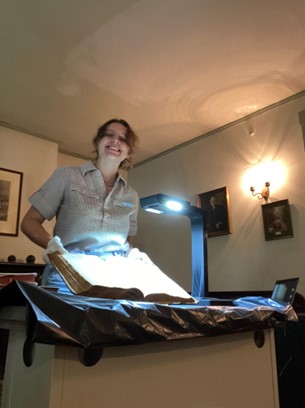Learning through ledgers: How an internship at Cooch’s Bridge sparked ongoing study
By Annie Hicks, historical interpreter, Cooch’s Bridge Historic Site
The Cooch’s Bridge Historic Site has a rich history, often associated with the Revolutionary War but expanding into Indigenous, African American and women’s history as well. I was first introduced to Cooch’s Bridge through a museum studies course offered at the University of Delaware and have since worked there both as an intern and a historical interpreter. The majority of my research this past year has focused on revealing more details about historically underrepresented groups at the various mills present at the site. The first mill, owned by Thomas Cooch Sr., may have been burned by the British following the Battle of Cooch’s Bridge in September 1777. The second mill was built in 1792 and was run by William Cooch Sr. and eventually passed down to his son, William Cooch Jr. The final mill was built by the Cooch family in the early 1800s and was later purchased by John W. Dayett, giving it the current name: the Cooch-Dayett Mill.
Throughout my time at Cooch’s Bridge, I completed a few small projects that created a foundation for the site’s interpretive plan. One of the most exciting elements of working at Cooch’s Bridge has been analyzing original documents from the Cooch family mills dating back to 1792. There are a plethora of daybooks and ledgers meticulously written by the Cooch millers and their employees over decades of mill operations. During my internship in the summer of 2022, I was able to read, digitize and transcribe thousands of entries from these documents. I am currently continuing this work and some archival research to trace the genealogy and histories of individuals of interest, mainly focusing on African Americans, women and those employed by the Cooch family throughout the 18th and 19th centuries. Through these projects, I have been able to present information in a more accessible and searchable format by digitizing and transcribing it in spreadsheets online.
Although many potential visitors are interested in learning about the homestead, much of the information we can gather comes from mill documents, which is why it’s important to read through them. With a site like Cooch’s Bridge, it’s important to interpret the entire history of the land and its peoples to properly serve community stakeholders and descendant groups. Luckily, the records available to us at Cooch’s Bridge give some insight into the lives of average Delawareans of various identities. By identifying people of interest that come from circles outside of the white, wealthy elite, future interpretation can use their narratives as lynchpin characters to present relatable, compelling stories about Delaware history.
Annie Hicks is a student at the University of Delaware majoring in history education with a museum-studies minor. Prior to joining the Cooch’s Bridge staff, they worked as an intern at the site transcribing legal documents and wills of the Cooch family with the goal of examining the roles of widows and other women, employees and the enslaved people who lived, worked and died on the property.





